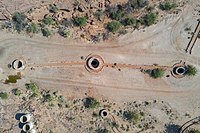Cultural area of Ḥimā
| Cultural area of Ḥimā | |
|---|---|
|
UNESCO world heritage |
|

|
|
|
Old South Arabic inscriptions |
|
| Contracting State (s): |
|
| Type: | Culture |
| Criteria : | (iii) |
| Reference No .: | 1619 |
| UNESCO region : | Arabic states |
| History of enrollment | |
| Enrollment: | 2021 ( session 44th ) |
Cultural area of Ḥimā , also Bir Ḥimā ( Arabic بئر حما, DMG Biʾr Ḥimā ), is a collective name for more than a hundred individual cultural sites with rock carvings in the province of Najran in the southwest of what is now Saudi Arabia . They are located about 200 km north of Najran on the eastern edge of the Hejaz sandstone plateau. In the rocky gorges were in the time from about 7000 to 1000 BC. Chr. Rock engravings attached, which tell of the Epipalaeolithic and Neolithic cultural and natural area of southern Arabia. Monumental inscriptions from the following millennia are also preserved there.
Location of the cultural area of Ḥimā |
contents
Animals (e.g. lions, cheetahs, ostriches, oryx antelopes, ibexes, giraffes), people (including tattooed women, warriors with clubs and lances, hunters with prey, shepherds with flocks, camel riders, dancers and entire battle scenes), texts ( various ancient South Arabian Inscriptions, including Sabaean and Musnad, but also Nabatean and even Greek ) as well as so-called wusum (singular: wasm ): the latter are the signatures of individual artists or their tribes, of which over a thousand different have been identified. The researcher Majeed Khan even speculated that the first writing systems developed from the wusum .
In addition to the drawings, tools were also found with which they were made: stones (such as quartzite , andesite , flint ) as well as bronze tools . There were also ancient wells, burial places and cairns .
The wells of Bir Ḥimā were the last watering place for caravans on the way through the desert to the north and the first to the south.
History of discovery and world cultural heritage
The area in the Empty Quarter was explored in 1951 during an expedition by Gonzague (1887–1969) and Jacques Ryckmans (1924–2005), St. John Philby and Philippe Lippens (1910–1985), who found a total of 12,000 petroglyphs along their route . The engravings of Hima were described in more detail by E. Anati in the years 1969 to 1972, who still dated them to the years 300 to 200 BC. Dated. In 1976 also the Saudi Arabian started Department of Antiquities and Museums for the findings to be interested, as in Jubba in the province of Ha'il also Stone Age drawings were found. A publication from 2010 named 6,400 figures for Bir Hima, including 1,300 people and 1,800 camels.
On July 21, 2021, the “Cultural Area of Ḥimā” was included in the UNESCO World Heritage List at the 44th session of the World Heritage Committee , after the sites in the Ha'il province had already been declared a World Heritage Site in 2015.
gallery
Web links
Individual evidence
- ↑ Al Arabiya: Bir Hima rock petroglyphs in Saudi Arabia's Najran include image of camel , accessed August 28, 2021.
- ↑ Uwe George : Between Stone Age Archives and Black Gold. In: Geo-Magazin . December 2002, p. 39 f.
- ↑ a b Ancient cultures.info: Introduction to Saudi Arabia Rock Art and Petroglyphs (PDF), published December 2010, accessed on August 28, 2021.
- ↑ UNESCO Nomination Document. (PDF; 2.0 MB) UNESCO, p. 12 , accessed on September 5, 2021 (English).
- ↑ Muhammed Abdul Nayeem: The rock art of Arabia: Saudi Arabia, Oman, Qatar, the Emirates & Yemen. Hyderabad Publishers, 2000, ISBN 81-85492-09-3 , p. 231.
- ↑ Ḥimā Cultural Area. UNESCO World Heritage List, accessed September 4, 2021 .






